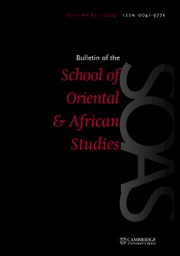Mathieu Tillier's monograph on “the invention of the qāḍī” in early Islam is a path-breaking work of legal and institutional history. The reason it offers such a satisfying read is that it takes a core Islamic institution that is so universally known that the Arabic word has been adopted into most languages as is, and asks a series of deceptively simple but illuminating questions about it: when did the office of the qāḍī emerge? In what context did it develop? How did it relate to the governmental and religious institutions that the Muslims encountered in the course of their conquests?
The greatest methodological advance of Tillier's work lies in its elegant fusion of the yin and yang of the study of Islamic history: he combines literary sources (whether descriptive, such as chronicles and biographies, or prescriptive, such as legal handbooks), on the one hand, with legal documents, which provide a direct but fragmentary window into law at work, on the other. Tillier's work thus constitutes an invaluable improvement on Tyan's still widely used two-volume Histoire de l'organisation judiciaire en pays d'Islam (Leiden: Brill, 1960), which used anecdotal evidence of the behaviour of individual judges, together with prescriptive writings on judgeship and legal procedure, to paint a picture of the qāḍī that was thin on granular detail and essentialist in the sense that it tended towards describing a timeless archetype, rather than an office that emerged in and changed over time.
The first part of the book examines the documentary evidence for early Islamic judiciary practices, which survives mainly on papyri from Egypt and Palestine. Surprisingly, the qāḍī and his court do not make an appearance in these texts until the end of the Umayyad period (661–750). Instead, we encounter a different kind of justice, one enacted by local pagarchs (a late antique administrative post adopted by the Muslim conquerors and filled in the early period by Christians) in consultation with and under the direction of the Muslim governor in the capital. This image of the early Islamic judicial landscape contradicts the literary sources written in later centuries, which claim that the office of the qāḍī emerged in the very first century of Islam. Tillier knows this, but he also knows that the early documents we possess carry a certain slant – they originate overwhelmingly from outside the great cities, which means that they represent the law as practised in the provinces, not in the metropoles. Perhaps the power of the qāḍī simply did not reach into the countryside, where the vast majority of Muslims resided. The governor, however, used local bureaucratic agents to collect taxes, and he also used these channels to maintain a basic legal order. Tillier wisely abstains from committing himself to either position on the question of whether the office of the qāḍī existed already before the late Umayyad era. Instead, he points to as yet unstudied documents from the Egyptian capital Fustat that might be able to shed decisive light on this question. This constitutes an important research agenda for future work on these papyri.
The second part of the book delves into the literary sources on the early history of the office. Lists and biographies of early qāḍīs appear relatively late in the literature, but the material they contain displays a remarkable degree of verisimilitude. The judges they depict are neither saints nor villains, and they practise a law that sometimes diverges in significant ways from later accepted legal norms. On the basis of his summary analysis, Tillier concludes that we can reconstruct the existence of and practices of qāḍīs in the first half of the eighth century. He then proceeds to construct an image of the judge from the ground up, in as differentiated a manner as possible, shedding light on such questions as where the judge held court in different cities, how litigants petitioned the court, where they were placed within it, and what other officials served the court under the qāḍī.
In the final part of the book, Tillier turns to the question of the “origin” of the office of the qāḍī. Previous studies (such as Tyan's, or von Grunebaum's 1939 review of Tyan in JAOS, or the work of Crone and Hallaq on Islamic law in general) have generally posited a particular pre-Islamic source of Islamic institutions. Tillier argues convincingly, first, that our knowledge of late antique law in the Near East is too patchy to allow us to discern exactly the kinds of legal cultures the Arab conquerors inherited and, second, that what we do know suggests that the process was not one of simple adoption but rather of the complex and gradual construction of a unified legal system that included existing elements but integrated them into a novel system with a high degree of homogeneity across the provinces.
Tillier's reading of the literary and documentary evidence is diligent, and his conclusions are restrained, thoughtful, and convincing. They pose a refreshing contrast with more flamboyant and speculative accounts of early legal institutions (such as Jokisch's in his Islamic Imperial Law and Crone's in her Roman Provincial Law). Its lack of sensationalism, combined with the fact that it is written in French, has unfortunately limited the impact of the book on the field. The language barrier, at least, has now been to some degree removed by the availability of an open-access online version of the book (at https://books.openedition.org/psorbonne/36105?lang) that yields a decent automatic translation into English – good enough, in my experience, to use in the classroom. Tillier's work shows what legal history can look like when the sources are considered holistically in their variety. Much has been achieved by Tillier, much more remains to be done in this important area.



